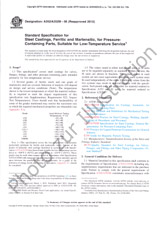Wir benötigen Ihre Einwilligung zur Verwendung der einzelnen Daten, damit Sie unter anderem Informationen zu Ihren Interessen einsehen können. Klicken Sie auf "OK", um Ihre Zustimmung zu erteilen.
ASTM D7208-14e1
Standard Test Method for Determination of Temporary Ditch Check Performance in Protecting Earthen Channels from Stormwater-Induced Erosion (Includes all amendments And changes 2/15/2023).
Name übersetzen
NORM herausgegeben am 1.1.2014
Informationen über die Norm:
Bezeichnung normen: ASTM D7208-14e1
Anmerkung: UNGÜLTIG
Ausgabedatum normen: 1.1.2014
SKU: NS-845281
Zahl der Seiten: 8
Gewicht ca.: 24 g (0.05 Pfund)
Land: Amerikanische technische Norm
Kategorie: Technische Normen ASTM
Kategorie - ähnliche Normen:
Die Annotation des Normtextes ASTM D7208-14e1 :
Keywords:
erosion control, scour, sediment, soil loss, temporary ditch check,, ICS Number Code 93.140 (Construction of waterways, ports and dykes)
Ergänzende Informationen
| Significance and Use | ||||||||||
|
5.1 This test method evaluates a system of temporary ditch checks and their means of installation to: 5.1.1 Reduce soil loss and sediment concentrations in stormwater runoff under conditions of varying channel conditions and soil type; and 5.1.2 Improve water quality exiting the area disturbed by earthwork activity by reducing suspended solids. 5.2 This test method models and examines conditions typically found on construction sites involving earthwork activities, including: highways and roads; airports; residential, commercial and industrial developments; pipelines, mines, and landfills; golf courses; etc. 5.3 This test method is a performance test. It is a comparative tool for evaluating the erosion control characteristics of different temporary ditch checks and can be used for quality control to determine product conformance to project specifications. Take caution when comparing results from different laboratories because information about between-laboratory precision is incomplete and slight differences in soil and other environmental and geotechnical conditions may affect temporary ditch check performance. Unique project-specific conditions should be taken into consideration. 1.1 This test method covers the
guidelines, requirements, and procedures for evaluating the ability
of temporary ditch check systems to protect earthen channels from
stormwater-induced erosion. Critical elements of this protection
are the ability of the temporary ditch check to:
1.1.1 Slow or pond runoff, or both, to encourage sedimentation, thereby reducing soil particle transport downstream; 1.1.2 Trap soil particles up stream of structure; and 1.1.3 Decrease soil erosion. 1.2 This test method utilizes full-scale testing procedures, rather than reduced-scale (bench-scale) simulation, and is patterned after conditions typically found on construction sites at the conclusion of earthwork operations, but prior to the start of revegetation work. Therefore this test method considers only unvegetated conditions. 1.3 This test method provides a comparative evaluation of a temporary ditch check to baseline bare soil conditions under controlled and documented conditions. 1.4 All observed and calculated values shall conform to the guidelines for significant digits and rounding established in Practice D6026 unless superseded by this standard. 1.4.1 The procedures used to specify how data are collected/recorded and calculated in this standard are regarded as the industry standard. In addition, they are representative of the significant digits that should generally be retained. The procedures used do not consider material variation, purpose for obtaining the data, special purpose studies, or any considerations for the user’s objectives; and it is common practice to increase or reduce significant digits of reported data to commensurate with these considerations. It is beyond the scope of this standard to consider significant digits used in analysis methods for engineering design. 1.5 The values stated in SI units are to be regarded as standard. The values given in parentheses are mathematical conversions to inch-pound units, which are provided for information only and are not considered standard. 1.6 This standard does not purport to address all of the safety concerns, if any, associated with its use. It is the responsibility of the user of this standard to establish appropriate safety and health practices and determine the applicability of regulatory limitations prior to use. Also, the user must comply with prevalent regulatory codes, such as OSHA (Occupational Health and Safety Administration) guidelines, while using the test method. |
||||||||||
| 2. Referenced Documents | ||||||||||
|



 Cookies
Cookies
